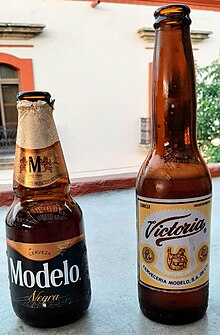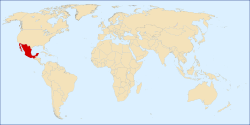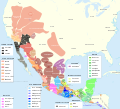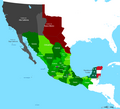Portal:Mexico
|
The Temple of Warriors at Chichen Itza, Mexico
¡Bienvenido! Welcome to the Mexico portal
Mexico, officially the United Mexican States, is a country in the southern portion of North America. It covers 1,972,550 km2 (761,610 sq mi), making it the world's 13th-largest country by area; with a population of almost 130 million, it is the 10th-most-populous country and the most populous Spanish-speaking country. Mexico is organized as a federal constitutional republic comprising 31 states and Mexico City, its capital. It shares land borders with the United States to the north, with Guatemala and Belize to the southeast; as well as maritime borders with the Pacific Ocean to the west, the Caribbean Sea to the southeast, and the Gulf of Mexico to the east.
This is a Featured article, which represents some of the best content on English Wikipedia.
 The Battle of Lipantitlán, also known as the Battle of Nueces Crossing, was fought along the Nueces River on November 4, 1835 between the Mexican Army and Texian insurgents, as part of the Texas Revolution. After the Texian victory at the Battle of Goliad, only two Mexican garrisons remained in Texas, Fort Lipantitlán near San Patricio and the Alamo Mission at San Antonio de Béxar (modern-day San Antonio in the U.S. state of Texas). Fearing that Lipantitlán could be used as a base for the Mexican army to retake Goliad and angry that two of his men were imprisoned there, Texian commander Philip Dimmitt ordered his adjutant, Captain Ira Westover, to capture the fort. The commander of Fort Lipantitlán, Nicolás Rodríguez, had been ordered to harass the Texian troops at Goliad. Rodríguez took the bulk of his men on an expedition; while they were gone, Westover's force arrived in San Patricio. On November 3, a local man persuaded the Mexican garrison to surrender, and the following day the Texians dismantled the fort. Rodríguez returned as the Texians were crossing the swollen Nueces River to return to Goliad. The Mexican soldiers attacked. After a short period, the Mexicans retreated. One Texian was injured, 3–5 Mexican soldiers were killed, and 14–17 were wounded. (Full article...)Selected article - Tourism in Mexico is a very important industry. Since the 1960s, it has been heavily promoted by the Mexican government as "an industry without smokestacks". Mexico has traditionally been among the most visited countries in the world according to the World Tourism Organization, and it is the second-most visited country in the Americas, after the United States. In 2017, Mexico was ranked as the sixth-most visited country in the world for tourism activities. Mexico has a significant number of UNESCO World Heritage Sites, with the list including ancient ruins, colonial cities, and natural reserves, as well as a number of works of modern public and private architecture. Mexico has attracted foreign visitors beginning in the early nineteenth century, with its cultural festivals, colonial cities, nature reserves and the beach resorts. The nation's temperate climate and unique culture – a fusion of the European and the Mesoamerican – are attractive to tourists. The peak tourism seasons in the country are during December and the mid-Summer, with brief surges during the week before Easter and Spring break, when many of the beach resort sites become popular destinations for college students from the United States. The majority of tourists come to Mexico from the United States and Canada. Other visitors come from other Latin American countries. A small number of tourists also come from Europe and Asia. (Full article...)Selected pictureThis is a Good article, an article that meets a core set of high editorial standards.
Mis Boleros Favoritos (English: My Favorite Boleros) is a compilation album by Mexican singer Luis Miguel. Released on 8 October 2002 by Warner Music Latina, it contains thirteen previously-recorded songs from the Romance-themed albums as well as a new track "Hasta Que Vuelvas". A special edition of the record was released on the same day and includes a DVD containing seven music videos from the bolero-themed discs. "Hasta Que Vuelvas" was released as a single for the album and peaked at number 16 on Billboard's Hot Latin Songs chart in the United States. Iván Adaime of AllMusic gave the album a 3.5 out of 5 star rating citing that the new song and music videos are the only incentives for fans to buy it and noted the album's purpose to end the Romance era. "Hasta Que Vuelvas" received a Latin Grammy nomination for Record of the Year in 2003. Commercially, Mis Boleros Favoritos peaked at number three on Billboard's Top Latin Albums chart in the United States, number one in Spain, and number seven in Argentina. (Full article...) Selected biography -Francisco "Pancho" Villa (/ˈviːə/ VEE-ə, also US: /ˈviːjɑː/ VEE-yah; Spanish: [ˈbiʎa]; born José Doroteo Arango Arámbula, 5 June 1878 – 20 July 1923) was a Mexican revolutionary and general in the Mexican Revolution. He was a key figure in the revolutionary movement that forced out President Porfirio Díaz and brought Francisco I. Madero to power in 1911. When Madero was ousted by a coup led by General Victoriano Huerta in February 1913, Villa joined the anti-Huerta forces in the Constitutionalist Army led by Venustiano Carranza. After the defeat and exile of Huerta in July 1914, Villa broke with Carranza. Villa dominated the meeting of revolutionary generals that excluded Carranza and helped create a coalition government. Emiliano Zapata and Villa became formal allies in this period. Like Zapata, Villa was strongly in favor of land reform, but did not implement it when he had power. At the height of his power and popularity in late 1914 and early 1915, the U.S. considered recognizing Villa as Mexico's legitimate authority. Civil war broke out when Carranza challenged Villa. Villa was decisively defeated by Constitutionalist general Álvaro Obregón in summer 1915, and the U.S. aided Carranza directly against Villa in the Second Battle of Agua Prieta in November 1915. Much of Villa's army left after his defeat on the battlefield and because of his lack of resources to buy arms and pay soldiers' salaries. Angered at the U.S. aid to Carranza, Villa conducted a raid on the border town of Columbus, New Mexico to goad the U.S. into invading Mexico in 1916. Despite a major contingent of soldiers and superior military technology, the U.S. failed to capture Villa. When Carranza was ousted from power in 1920, Villa negotiated an amnesty with interim President Adolfo de la Huerta and was given a landed estate, on the condition he retire from politics. Villa was assassinated in 1923. Although his faction did not prevail in the Revolution, he was one of its most charismatic and prominent figures. (Full article...)
In the news
Selected fare or cuisine - History of beer in Mexico dates from the Spanish conquest of the Aztec Empire. While Mesoamerican cultures knew of fermented alcoholic beverages, including a corn beer, long before the 16th century, European style beer brewed with barley was introduced with the Spanish invasion soon after Hernán Cortés's arrival. Production of this beer here was limited during the colonial period due to the lack of materials and severe restrictions and taxes placed on the product by Spanish authorities. After the Mexican War of Independence, these restrictions disappeared, and the industry was permitted to develop. Furthermore, the arrival of German immigrants during the ephemeral Second Mexican Empire of elected Maximilian I of Mexico, born an Austrian archduke, in the 19th century provided the impetus for the opening of many breweries in various parts of the country. By 1918, there were 36 brewing companies, but over the 20th century, the industry consolidated until today, only two corporations, Grupo Modelo (now owned by AB InBev) and Cervecería Cuauhtémoc Moctezuma formerly known as FEMSA Cerveza (now owned by Heineken N.V.) control 90% of the Mexican beer market. This industry is one of the most prevalent in the country, with over 63% of the population buying one brand or another. Beer is also a major export for the country, with most going to the United States, but is available in over 150 countries worldwide. In 2022, Mexico was the largest beer exporter in the world. (Full article...)
General imagesThe following are images from various Mexico-related articles on Wikipedia.
CategoriesTopicsRelated portalsWikiProjectYou are invited to participate in WikiProject Mexico, a WikiProject dedicated to developing and improving articles about Mexico. Associated WikimediaMore portals | ||||||||||
























































































